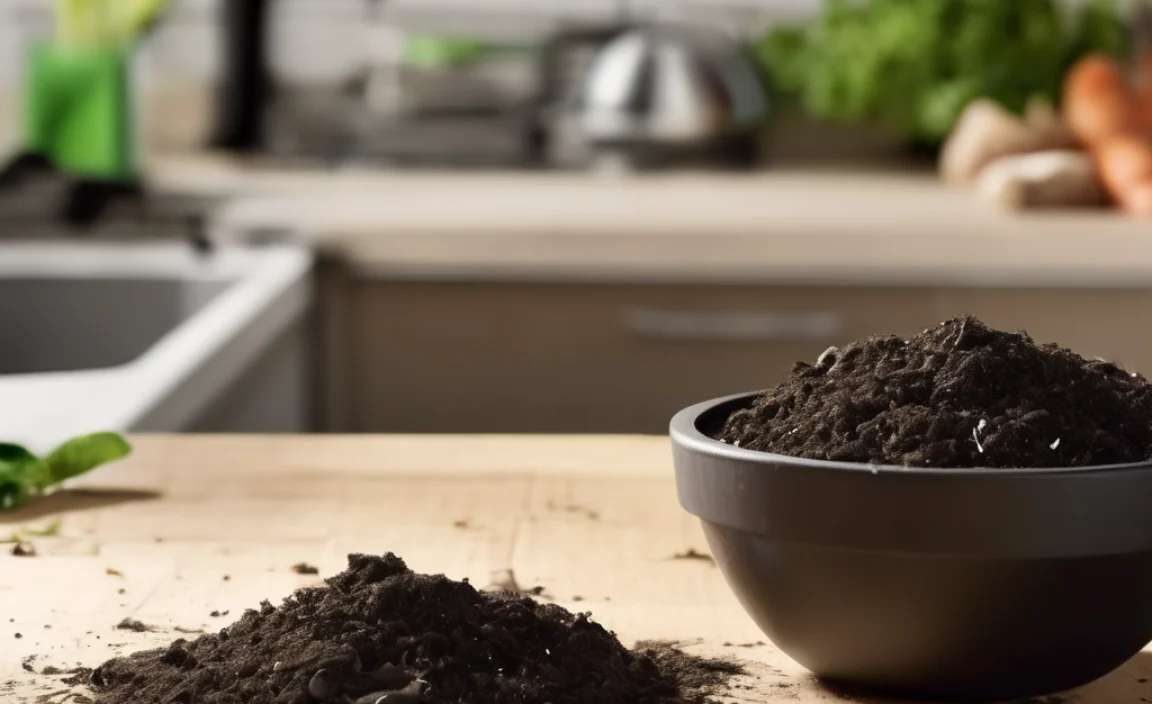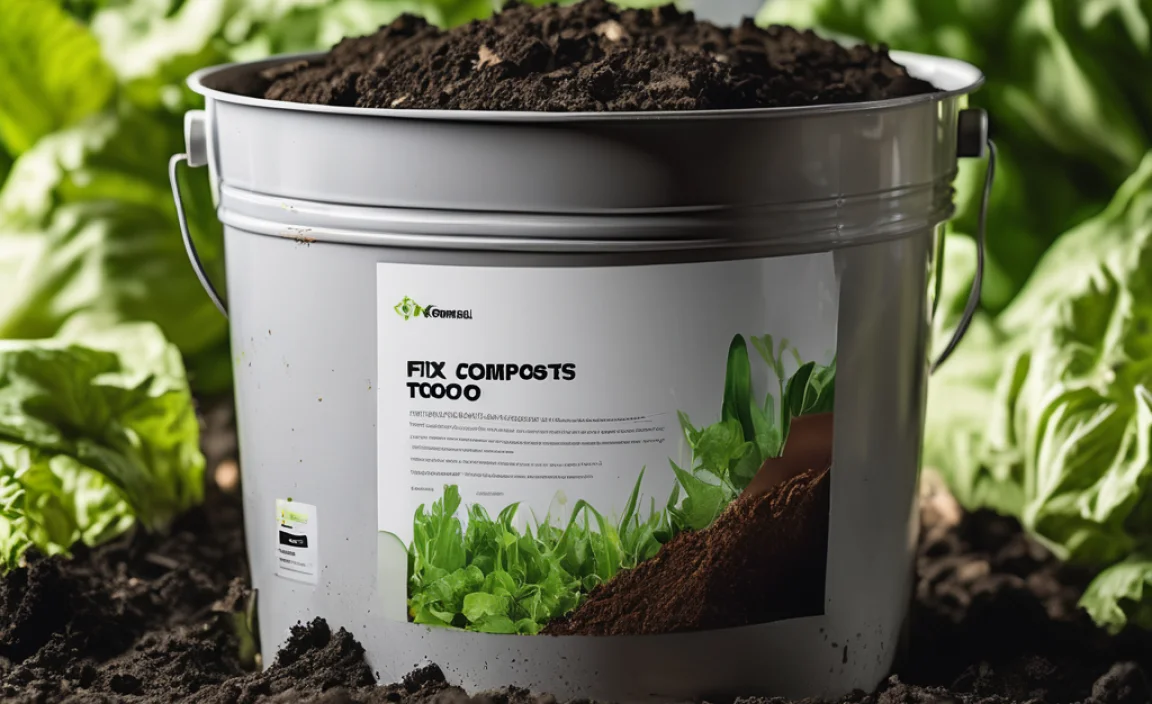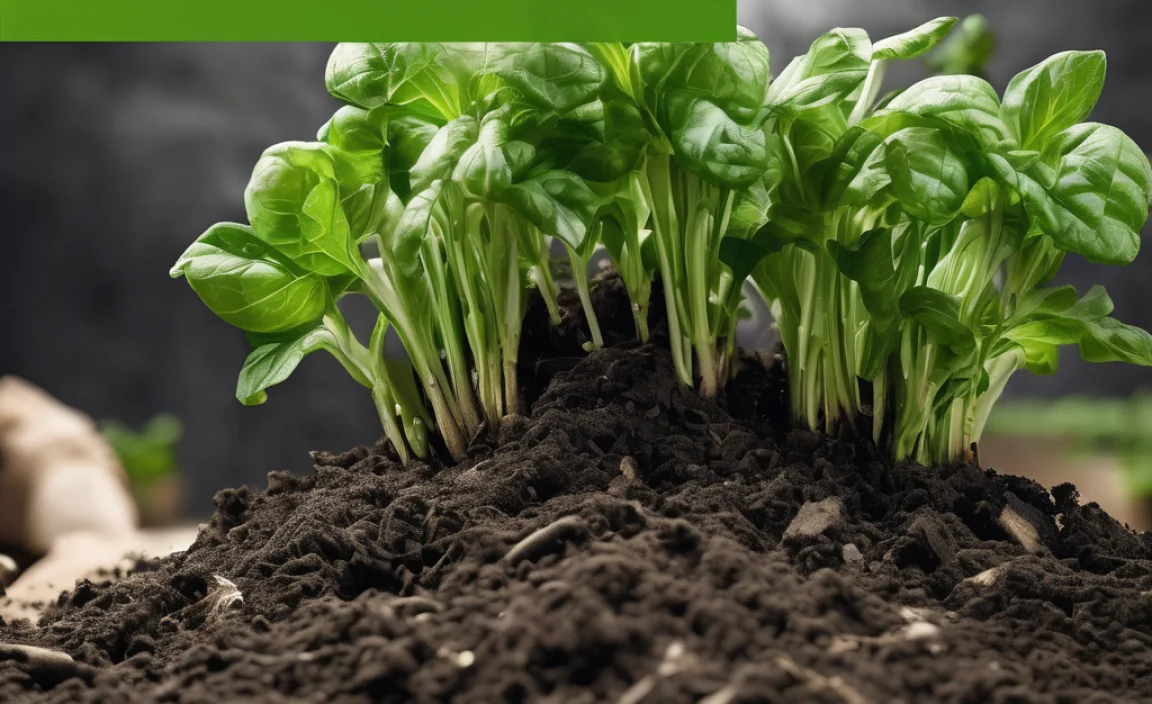Is your compost pile making your garden feel a little gloomy? Maybe your plants aren’t thriving like they should, or you’ve noticed your compost smells a bit off. Don’t worry, it’s likely a pH issue, and thankfully, it’s usually super easy to fix! Just like we can tune up our cars for better performance, we can do the same for our compost. This guide will walk you through exactly why your compost might be too acidic and, more importantly, how to fix it with simple, everyday ingredients. Let’s get your compost back to its happy, healthy, nutrient-rich best!
Why Compost Can Become Too Acidic

Think of your compost pile as a tiny ecosystem. Lots of different things are happening in there, and sometimes, the balance can tip a little. When compost gets too acidic, it means there’s an excess of ‘acid-forming’ materials compared to ‘alkaline-forming’ ones. This can happen for a few key reasons, and understanding them is the first step to a quick fix.
The Usual Suspects: What Makes Compost Acidic?
- Too Many “Greens”: Our compost piles are made of “greens” (nitrogen-rich materials like grass clippings, kitchen scraps) and “browns” (carbon-rich materials like dry leaves, cardboard). An overload of fresh, wet greens without enough browns can lead to a condition called anaerobic decomposition, which produces acids. It’s like making a smoothie with too much fruit and not enough of something to balance it out!
- Certain Food Scraps: Some common kitchen items, like citrus peels (oranges, lemons, grapefruits) and tomatoes, are naturally acidic. While they’re compostable, adding too many without balancing them can nudge your compost pile’s pH in the wrong direction.
- Coniferous Materials: Needles from pine, fir, and spruce trees are quite acidic. Adding large quantities of these to your compost can lower its pH over time.
- Poor Aeration: If your compost pile doesn’t get enough air (oxygen), the decomposition process can become stagnant and anaerobic. Anaerobic conditions are ripe for acid production. This is why turning your compost is so important!
- Rain and Moisture: Excessive rain can leach out beneficial alkaline compounds, leaving the pile more acidic, especially if it’s not covered.
The Tell-Tale Signs: How Do You Know Your Compost is Too Acidic?

Before we jump into solutions, let’s make sure you’re dealing with an acidic compost pile. There are a few clues to look out for. Some are based on what you smell and see, while others require a simple test.
Sensory Clues
- Ammonia or Sour Smell: A healthy compost pile should smell earthy, like a forest floor after rain. If it smells sharply of ammonia (like strong urine) or has a sour, vinegary whiff, it’s a strong indicator of too much acidity and often anaerobic conditions.
- Slow Decomposition: If your compost pile isn’t breaking down material as quickly as it should, or it just looks like a soggy, slimy mess, acidity could be the culprit. Acidic conditions can slow down or even halt the work of beneficial microbes.
- Slimy or Sticky Texture: A healthy compost pile should have a crumbly, airy texture. If it feels overly wet, slimy, or sticky, it’s often a sign of too much moisture and potentially imbalanced pH.
Using a pH Test Kit
The most reliable way to know for sure is to test your compost’s pH. You can do this easily with a compost or soil pH test kit, which you can find at most garden centers or online. These kits are usually very straightforward to use.
How to Test Your Compost’s pH:
- Collect a Sample: Dig a small amount of compost from the middle of your pile, as this is where the most active decomposition is happening.
- Prepare the Sample: Follow the instructions on your pH test kit. Usually, you’ll need to mix a small amount of compost with distilled water (tap water can affect the reading).
- Perform the Test: Whether it’s a liquid kit, a probe tester, or a paper strip, follow the kit’s specific directions.
- Read the Results: The kit will give you a reading. A healthy compost pile typically has a pH between 6.0 and 7.5. Anything consistently below 6.0 is considered acidic.
Effortless Solutions: How to Fix Compo Too Acidic

Alright, you’ve identified an acidic compost pile. Don’t sweat it! This is a common issue, and the fixes are simple and don’t require fancy equipment. The key is to introduce alkaline materials and improve aeration.
1. Add Alkaline “Amendments”
This is the most direct way to raise the pH of your compost. Think of these as the opposite of acidic materials – they help neutralize the excess acid.
- Wood Ash: This is a fantastic, readily available source of alkalinity (calcium carbonate). However, use it sparingly! Too much wood ash can make your compost too alkaline and introduce unwanted salts. Aim for a light dusting. It’s best to use ash from untreated, natural wood. Wood ash is a great source of nutrients, too! For more on its benefits and proper use, check out Clemson University’s Home & Garden Information Center.
- Garden Lime (Agricultural Lime): Also known as calcitic lime or dolomitic lime, this is a common soil amendment used to raise pH. Agricultural lime is a gentler option than quicklime. Sprinkle a small amount over your compost pile, especially if you’re noticing a strong sour smell. Don’t overdo it, as it can create a very alkaline environment. A little goes a long way.
- Crushed Oyster Shells: If you have access to them, crushed oyster shells are another good source of calcium carbonate and will slowly release alkalinity into your compost.
- Eggshells: While not as potent as wood ash or lime, finely crushed eggshells can contribute a small amount of calcium and help buffer acidity over time. Make sure they are thoroughly washed and then crushed as finely as possible.
How to Apply: When adding these amendments, it’s best to sprinkle them as a thin layer or dust them over the compost. Then, gently turn the pile to incorporate them. You don’t want to dump large clumps in one spot.
2. Boost Your “Browns” Content
Adding more carbon-rich “brown” materials is crucial for balancing out the “greens” and improving aeration. This helps the whole decomposition process work more efficiently and reduces the production of acids.
- Shredded Cardboard and Paper: Uncoated cardboard (like from shipping boxes) and plain newspaper (avoid glossy inserts) are excellent brown materials. Shred them into small pieces to help them break down faster.
- Dry Leaves: Fallen leaves are nature’s perfect compost ingredient. If you have a surplus, especially in the fall, rake them up, shred them if possible, and add them to your pile.
- Straw or Hay: If you have access to these, they are fantastic brown materials. Make sure they haven’t been treated with herbicides.
- Sawdust/Wood Shavings: Use these sparingly, as they take longer to break down and can sometimes mat together, reducing airflow. Ensure they are from untreated wood.
How to Apply: When you add your greens (like kitchen scraps), make sure to bury them within a layer of browns. Ideally, aim for a ratio of roughly 2-3 parts browns to 1 part greens by volume. If your pile is already too acidic and wet, adding a good amount of shredded browns will help absorb excess moisture and introduce the needed carbon.
3. Improve Aeration (Turn Your Compost!)
This is arguably the most important step for any compost pile, especially an acidic one. Lack of oxygen is a primary driver of anaerobic (acid-producing) decomposition. Turning your compost mixes everything, introduces fresh air, and helps to evenly distribute moisture and heat.
- How Often: Aim to turn your compost pile at least once every 1-2 weeks, especially when trying to fix acidity. More frequent turning can speed things up even more.
- How to Turn: Use a compost fork, pitchfork, or even a sturdy shovel. Start by digging into the pile and turning the outer materials into the center, and the bottom materials up to the top. The goal is to mix everything thoroughly.
- Make it Easier: Consider building your compost bin with good airflow in mind. Bins made from pallets or with vented sides are excellent.
For a deeper dive into best composting practices, including aeration and ratios, the U.S. Environmental Protection Agency (EPA) offers comprehensive guidance.
4. Manage Moisture Levels
Compost needs to be moist, like a wrung-out sponge, but not waterlogged. Excess moisture can contribute to anaerobic conditions and wash away beneficial elements. Conversely, if it’s too dry, decomposition slows down drastically.
- If it’s too wet: Add more “brown” materials (shredded cardboard, dry leaves). Turning the pile will also help it dry out. If your bin is exposed to a lot of rain, consider covering it with a tarp, especially during heavy downpours, but ensure air can still circulate.
- If it’s too dry: Lightly water the pile as you turn it. Use a hose with a spray nozzle or a watering can. Avoid drenching it.
5. Introducing Beneficial Microbes (Optional but Helpful)
Sometimes, the microbial community in your compost might be struggling. Adding a bit of finished compost, well-rotted manure, or a commercial compost starter can help reintroduce beneficial bacteria and fungi that are crucial for breaking down organic matter efficiently and maintaining the right balance.
Putting It All Together: A Step-by-Step Action Plan

Feeling overwhelmed? Don’t be! Here’s a simple, actionable plan to get your compost pile back on track. You can do this!
Quick Actions for an Acidic Compost Pile
- Step 1: Assess Your Pile. Smell it. Feel its texture. Is it sour or ammonia-like? Is it slimy and wet? If yes to any of these, it’s likely too acidic or heading that way.
- Step 2: Test the pH (Optional but Recommended). Use a pH test kit to confirm your suspicions. Knowing the exact pH helps tailor your approach.
- Step 3: Grab Your “Broil” Materials. Gather shredded cardboard, dry leaves, or straw.
- Step 4: Grab Your “Buffering” Materials. Get some wood ash (a dusting!), garden lime, or crushed eggshells.
- Step 5: Turn, Turn, Turn! Start by thoroughly aerating your pile. Dig it all up and mix it well.
- Step 6: Add Your Browns. Layer or mix in a generous amount of your gathered “brown” materials. This helps absorb excess moisture and balances the carbon-to-nitrogen ratio.
- Step 7: Add Your Alkaline Amendment. Sprinkle a light dusting of wood ash or a small amount of garden lime evenly over the turned compost. Mix it in gently.
- Step 8: Monitor Moisture. Check if the pile feels like a wrung-out sponge. Add a little water if dry, or more browns if too wet.
- Step 9: Repeat and Observe. Over the next few weeks, continue to turn your compost regularly (weekly is great) and monitor its smell and texture. You should notice an improvement!
- Step 10: Maintain Balance. Always try to add a good mix of greens and browns to your pile ongoingly. Burying kitchen scraps within layers of browns is a great habit.
Important Considerations: What NOT to Do

Just as important as knowing what to add is knowing what to avoid when trying to fix an acidic compost pile. A little caution goes a long way.
Things to Avoid
- Don’t Use Too Much Lime or Ash: Adding too much of these alkaline materials can shock your compost pile and make it too alkaline, which is also bad for decomposition. Stick to light dustings or small handfuls, especially when starting.
- Don’t Add Meat, Dairy, or Oily Foods: These items can attract pests, create foul odors, and contribute to anaerobic conditions, making your pH problem worse.
- Don’t Use Treated Wood or Wood Ash from Treated Wood/Coal: These can release harmful chemicals into your compost, which you don’t want in your garden soil.
- Don’t Ignore the Smell: A persistently bad smell is your compost’s way of telling you something is unbalanced. Address it promptly.
- Don’t Keep it Soggy: Always ensure good drainage and avoid letting your compost become a swamp.
When Can I Use My “Fixed” Compost?
Patience is key with composting, even when fixing issues. Once you’ve implemented these solutions and your compost pile begins to transform – smelling earthy, looking crumbly, and breaking down materials effectively – it’s getting closer to being ready. You can usually start using compost that’s dark, crumbly, and smells pleasant. If you’ve corrected acidity it will be well on its way. A good rule of thumb is that it should be at least 6 months old, but ideally a year or more for mature compost. You shouldn’t be able to recognize the original materials.
You can use your fixed compost as a top dressing for garden beds, mix it into planting holes, or incorporate it into potting soil. Your plants will thank you for the balanced, nutrient-rich goodness!
Conclusion
Navigating the world of composting is an adventure, and recognizing and fixing an acidic compost pile is a valuable skill for any gardener. We’ve seen that a too-acidic pile often stems from an imbalance of greens and browns, poor aeration, or certain acidic food scraps. But the good news is that restoring balance is well within your reach, and it doesn’t require expensive tools or complicated processes.
By simply observing your compost, adding alkaline amendments like wood ash or lime in moderation, boosting your “brown” materials, and most importantly, ensuring good aeration through regular turning, you can transform a struggling batch into the rich, earthy “black gold” your garden craves. Remember, composting is a journey, and with these practical steps, you’re well-equipped to overcome common challenges and cultivate a thriving compost system. Happy composting!
Frequently Asked Questions About Acidic Compost
Q1: How often should I check my compost’s pH if it’s acidic?
After you’ve added amendments and turned your pile, check the pH again after about 2-3 weeks. Continue monitoring every few weeks until it stabilizes within the healthy range (6.0-7.5). Regular turning and proper material balancing are more important than frequent testing once things are back on track.
Q2: Can I use baking soda to fix acidic compost?
While baking soda is alkaline, it’s generally not recommended for compost. It can lead to a rapid, temporary pH shift and introduce a lot of sodium, which isn’t beneficial for your compost or plants. Wood ash or garden lime are more appropriate and effective solutions.
Q3: My compost still smells sour even after adding browns and lime. What else can I do?
Sour smells often indicate a lack of oxygen. Make sure you are turning your pile thoroughly and frequently. If the pile is very wet, try adding even more shredded dry materials like cardboard or leaves to help absorb excess moisture and improve airflow. Ensure you are not adding too many “greens” at once without enough covering “browns.”
Q4: What is the ideal carbon-to-nitrogen (C:N) ratio for compost?
The ideal C:N ratio for fast, efficient composting is typically around 25:1 to 30:1. This means you need significantly more carbon-rich “brown” materials than nitrogen-rich “green” materials. Too many greens can lead to that sour, acidic smell and slow decomposition.
Q5: How much wood ash or lime should I add?
Start small! For a typical home compost bin (about 3x3x3 feet), a light dusting of wood ash like sprinkling powdered sugar, or perhaps 1/2 to 1 cup of garden lime, mixed well into the upper layers, is usually sufficient. Over-application is easy to do and can cause more problems. It’s better to add a little, wait, and re-test than to add too much at once.
Q6: Will acidic compost harm my plants?
If you apply very acidic compost directly to your garden, yes, it can harm your plants. High acidity can damage plant roots, prevent nutrient uptake, and create an environment that favors weeds and diseases over your desired plants. It’s crucial to fix the pH before using it.

I am passionate about home engineering. I specialize in designing, installing, and maintaining heating, ventilation, and air conditioning systems. My goal is to help people stay comfortable in their homes all year long.
